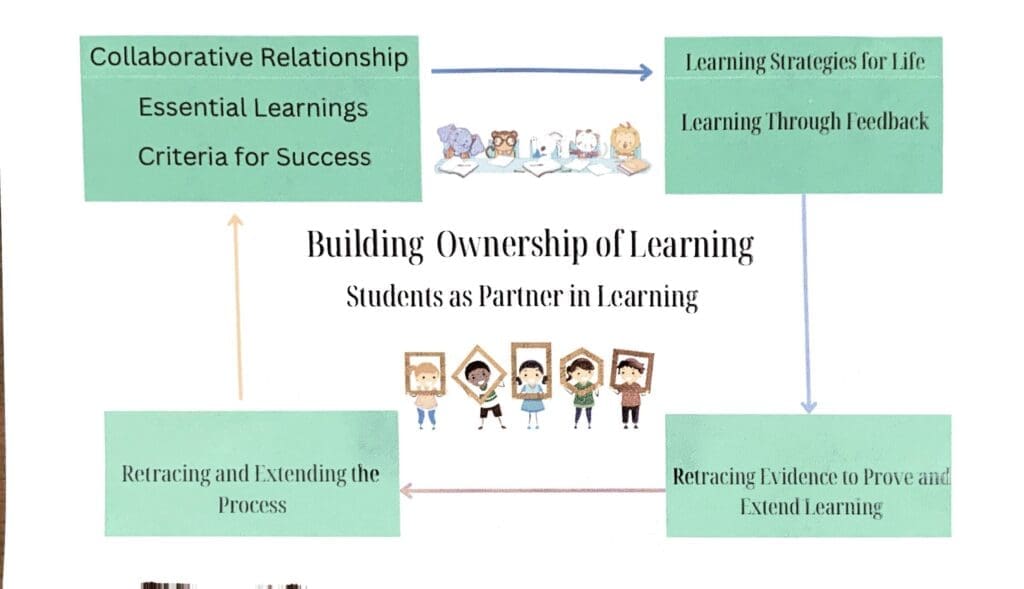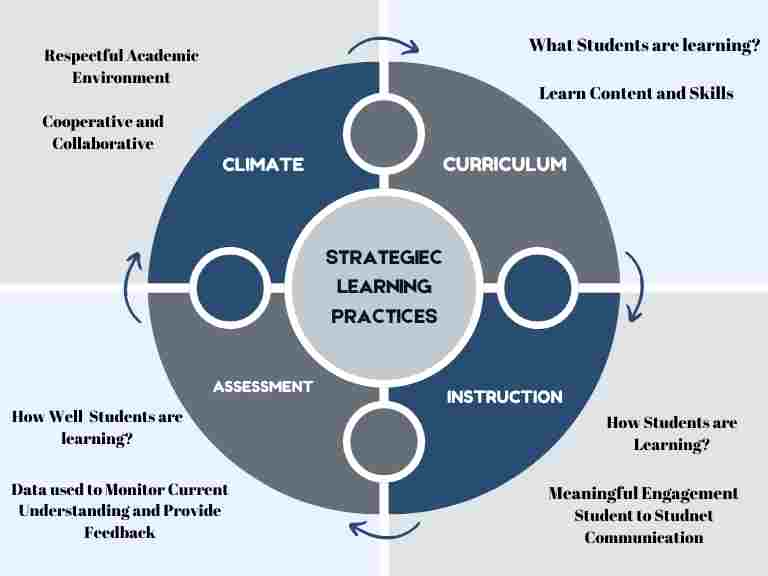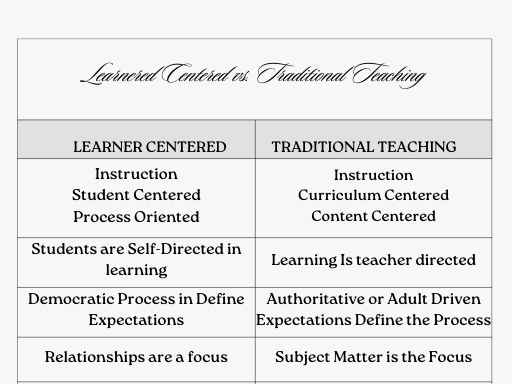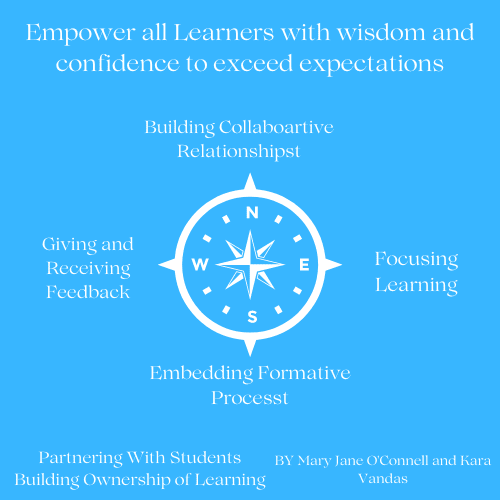
Building students ownership of learning
Building students ownership of learning means teachers and students both have equal responsibility to work together to empower students with knowledge and self-assurance to surpass their targets. This mutual commitment is emphasized in the title of the book “Partenering with Students” to Build Ownership of Learning.

Students as Partners in Learning Recap
The ‘handoff’ of learning represents the moment in the classroom when students are able to take ownership of their learning and become partners with their teacher and peers. It can only be achieved when teachers intentionally empower students” — “It’s is time to change the way we think about the role of students in the learning process. Students must move from being simply receivers of teacher knowledge to fully vested partners in constructing learning and becoming their own advocates and even teachers in the learning process.”
Larry Ainsworth Forward section of
O’Connell, M. and Vandas, K. (2015) Partnering With Students. 1st edn. Corwin. Available at: https://www.perlego.com/book/2034393 (Accessed: 30 June 2024).
According to National Institute Excellence for Teachers, emphasizes student ownership begins when the teacher examines the standards and content, including their curriculum, from the students’ point of view. As students move from doing to owning their learning, the teacher also shifts from directing learning most of the time to co-leading learning alongside students. Robert Crowe and Jane Kennedy, authors of Developing Student Ownership Supporting Students to Own Their Learning, also emphasize that the teacher needs to see from the students’ point of view, when examining the standards that include in their curriculum. This is where Strategic Learning Practices comes in.

Strategic Learning Practices
In Student Ownership, authors Robert Crowe and Jane Kennedy use various research studies to identify the most effective strategies for fostering student ownership of their learning. They emphasize the importance of developing strategic learning practices that focus on curriculum, instruction, assessment, and classroom climate.
Strategic learning practices are actions that provide students with the greatest opportunities to enhance their learning. These practices empower students by giving them the authority, capacity, and responsibility to take ownership of their educational journey.
Strategic Learning Practices emphasize the best practices in curriculum, instruction, assessment, and classroom climate. The objective is for each student to clearly articulate their understanding, thereby demonstrating increased ownership of their learning in these areas.
I revisited Crowe and Kennedy asking us to walk into a 3rd grade classroom and asking a student, “What are you learning today?” Now imaging hearing this:
Today, I am learning how to describe characters by their traits, motivations, and feelings. We are reading Charlotte’s Web, and I am describing Wilbur in chapter 3. I will know that I have done a good job taking notes on this by accurately filling out my character map. I am learning how to do this, because when we finish this book, I am writing an opinion essay on which character was most admirable: Charlotte, Wilbur, or Fern. I will take notes on all the characters to use as details in my essay. I am checking with my friends in my group, because they will help me figure out if I have left any important information out of my notes. I will help them, because that is how we help everybody in the class get smarter. —” (pg. 1)
Crowe and Kennedy ask educators to view it from a point of view of the teacher’s decision and actions. Crowe and Kennedy wrote the following:
For this student to explain as they did, it is clear that the implementation supported them of the strategic learning practices. Notice the plural. The power of these practices is their ability to integrate and build on one another. Relevant standards supported this third grade student with a measurable and achievable outcome accessible, and drove all learning (Curriuculum 1) within a lesson and unit that provided an integrated approach (Curriculum 2) using materials that matched the content and rigor of the learning outcome (Curriculum 3). The student had many opportunities for meaningful engagement using structured student-to-student communication (Instruction 1) and effective instructional strategies (instruction 2) while receiving and providing feedback (Assessment 1). An academic classroom climate also supported this student’s respectful (Climate 1), cooperative, and encourage risk taking (Climate 2) by having students share their strengths and challenges with one another.” (pg. 158)
Crowe and Kennedy believe this is a clear example of a student who owns their learning, because this student can articulate what they are learning, why they are learning it, how they will demonstrate they have learned it, how they are learning it, and how they will work with other students to support one another. What Crowe and Kennedy wrote gives me the motivation to support students to own their learning by writing an EBook on Strategic Learning Practices: A Teacher’s Guide to Curriculum, Instruction, and Assessment.
Coming Soon

Partner With Students in Learning
Read O’Connel and Vandas show how students can partner with teachers in their learning in the article “5 Steps to Partner with Students in Learning” .
Building Relationships
Educators know before students can be partners in learning there is the need to build relationships with the students. In their book Partnering with Students Building Ownership of Learning, Mary Jane O’Connell and Kara Vandas believe collaborative relationships for learning are the first step in building ownership of learning with students as partners. O’Connell and Vandas emphasizes Collaborative Relationships for Learning Illuminates the beliefs and behavior associated with positive teacher-student relationships, essential to creating a culture that accelerates student learning.
In students learning journey, they need to prepare to set goals, to fail, to get up and try a new strategy, to fail again, and to persist until their goals are realized. So, are all students in our classrooms equipped with the skills and confidence to take ownership of their learning? What can we do for students who are not prepared? O’Connell and Vandas ask educators to examine our beliefs about empowering students to own their learning. Here are questions to consider:
- How can relationships impede or catapult learning?
- How do I establish a classroom where learning is a partnership?
Examining Beliefs
O’Connell and Vandas invite educators to begin examining beliefs and practices by reviewing the descriptions used to broadly differentiate a learner-centered approach and traditional teaching. See Table Below:

I included some of the major differences that I thought were important.
O’Connell and Vandas ask educators to imagine you are a first-time visitor to your school and classroom. O’Connell and Vandas encourage you to step out of yourself and listen and look anew at the surroundings as you meander through the hallways and enter a few classrooms. What do you hear and see that suggests there is evidence of a learner-centered approach or a traditional approach from the above list. Make a list of the evidence of a learner-centered and tradition Teaching that you noticed in the classroom and afterwards, check your beliefs about your own classroom.
Invite Students to be Partners
O’Connell and Vandas urges you to invite students to be partners in learning once we have examined our beliefs about students and learning. According to O’Connell and Vandas, the focus here is to talk about students making decisions, crafting a classroom belief system, engaging in discussions about what worked and didn’t in class, and letting the power be shared in a partnership model. O’Connell and Vandas want to shift the focus from seeing students’ deficits to relying on their strengths, so we can establish the relationships that propel us forward as partners in learning.
You may ask how I do this in my classroom? I want to build stronger relationships. I want my students to believe in themselves as learners. But how? Where is the road map that guides me on my journey? O’Connell and Vandas developed the TRUST Model to provide a framework of actionable steps and essential parts supported by research to establish students as active partners in learning.
Read Strategies Better Collaborative Relationships for Learning post for strategies.
Let Students In on the Learning
Teachers today face great change in the education world, from new standards to new assessments to new evaluation systems. In a time fraught with change, we pose two critical questions: “Are we, as teachers, clear about what students must learn each year?” and more importantly, “Are our students clear about what they are expected to learn?”
Why are these questions so critical?
Students cannot be owners of their learning and partners with us if they are unclear about what they must know and do. Teachers cannot communicate clearly with students unless they are first clear about the learning expectations. What is the pay off if teachers are clear and work to help students be clear about learning? Teacher clarity alone can double the speed of learning. If students are clear and able to manage their own learning progress, the rate of learning can be tripled (Hattie, 2012). Taking time to be clear is clearly worth the effort!
Build Learner Capacity
Teachers work to employ strategies within the classroom to make learning more meaningful. Many effective strategies, such as using a Venn diagram or Cornell Notes, have become commonplace among many teachers. The question we pose is, “Are students transferring the strategies used in the classroom into their own toolbox for learning?” As teachers, we must become intentional about asking students to try, reflect, refine and amass strategies that work for them as learners. If you asked a student in the classroom today, what strategies work best for you as a learner, how many would give a thorough answer? Many may say, “I sometimes reread my notes.” Or “I find that talking with others helps me sort out my thinking.” This is a start, but not a reflection of students deeply knowing and cataloging what works for them as learners. We propose teachers spend time teaching, asking students to use and reflect on strategies for learning, and build a toolbox of strategies.
Prove and Celebrate Learning
Finally, we encourage students and teachers to take time to prove learning. What does this mean? When students receive an 80% on a post assessment, what is communicated with the score? Have they reached mastery? Have they met the learning goals? Which ones?
Too often, we leave students in the dark about their accomplishments as learners. Grades provide little information about what was actually learned. What if students reflected on their learning by aligning the learning goals and their personal goals with evidence in their own work? What if we took the time to deeply reflect on what we learned before we raced on to new standards? Would it change things?
Monitoring progress is a powerful motivator, and if students are given the time to understand the progress they made, they are empowered and inspired to make more and more progress (Hattie, 2012). They can then set future goals, celebrate their hard work and effort, and understand that they are growing, learning, and not just attending class.
O’Connell and Vandas ask is it totally out of the question to partner with students? Is it too far? Or is it exactly what we know kids today need? We now have the research on what works best (Hattie, 2012, 2009); how have we responded? O’Connell and Vandas encourage you to jump in with both feet.But it will take time.
Learning Journey Sign Post

Defining the Journey
Defining Collaborative Relationships for Learning Illuminates the beliefs and behavior associated with positive teacher-student relationships, essential to creating a culture that accelerates student learning.
Strategies Better Collaborative Relationships for Learning
Define Essential Learning establishes a step-by-step process teachers can follow to find clarity in what is essential for students to know and do.
How to Clarify Learning Progression Within Standards In 2 Steps
Defining Criteria for Success provides teachers with a process to translate the standards into meaningful learning intentions, criteria for success, and personal learning goals.
How to Increase Student Learning Through 4 Step Process
How to Help Your Students Achieve Success in 3 Effective Ways
Take your time to understand and apply these Defining the Journey in your teaching, because it is the foundation for student-centered learning.
Learning on the Journey
Learner Strategies for Life shine a powerful spotlight on no-cost instructional and learner strategies that can more than double the rate of learning.
What Are Learner Strategies? Why is Learner Strategies Important?
Learning Through Effective Feedback explores the often hidden element of reciprocal feedback in the classroom to establish the feedback structures and strategies that get results.
Success Criteria Effective Feedback You Need to Know
Retracing and Extending the Journey
Retracing evidence to prove and extend learning provides an eye-opening process in which students prove their learning by aligning evidence to the learning intentions, as they build awareness of what works for them as learners.
Post to come.
Retracing and extending the process is a summary to guide teachers and leaders that provide a critical view of the process, and outline a role for leaders by recognizing students as our greatest asset.
Post to come
